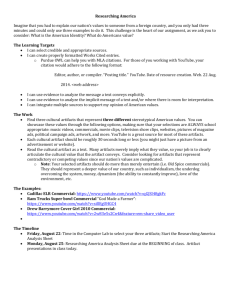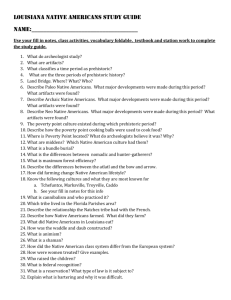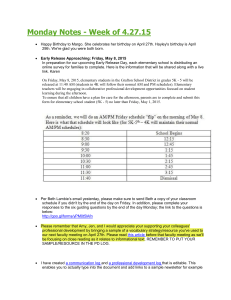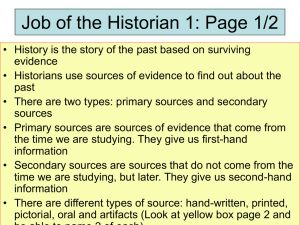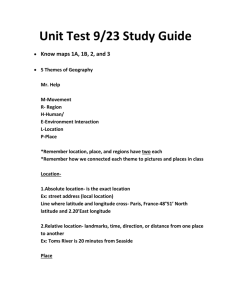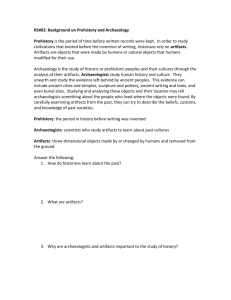Introduction of your Big Question posed as a thesis/arguable assertion
advertisement
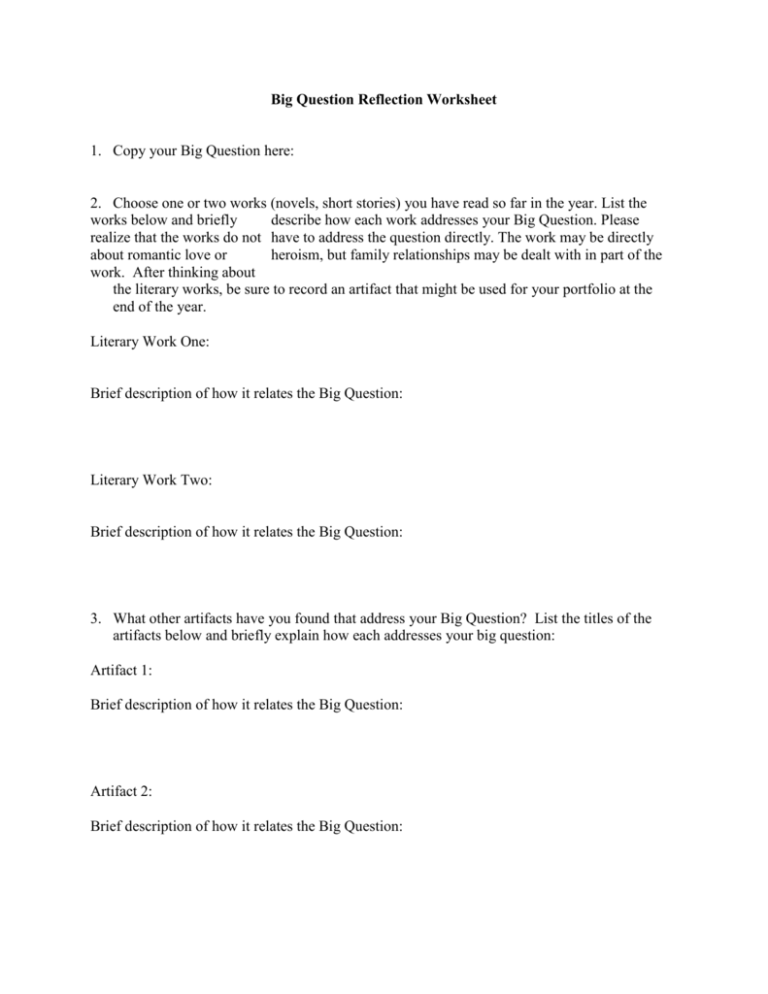
Big Question Reflection Worksheet 1. Copy your Big Question here: 2. Choose one or two works (novels, short stories) you have read so far in the year. List the works below and briefly describe how each work addresses your Big Question. Please realize that the works do not have to address the question directly. The work may be directly about romantic love or heroism, but family relationships may be dealt with in part of the work. After thinking about the literary works, be sure to record an artifact that might be used for your portfolio at the end of the year. Literary Work One: Brief description of how it relates the Big Question: Literary Work Two: Brief description of how it relates the Big Question: 3. What other artifacts have you found that address your Big Question? List the titles of the artifacts below and briefly explain how each addresses your big question: Artifact 1: Brief description of how it relates the Big Question: Artifact 2: Brief description of how it relates the Big Question: Artifact 3: Brief description of how it relates the Big Question: 4. Review your first attempt to answer your Big Question from Quarter One. How would you answer your Big Question now? Use the literary works and independently found artifacts to support your point. Ways to think about your artifacts: If your answer to the Big Question has changed since your Quarter One response, how has your reading of the literature in this class affected your perception of the issue? If your answer has not changed, how does the literature support your Quarter One answer? If your answer has changed, how did your independently gathered artifacts affect your perception of the issue? If your answer has not changed, how do the artifacts you have independently gathered support your Quarter One answer? Graphic Organizer for the Big Question Essay Introduction of your Big Question posed as a thesis/arguable assertion (intro paragraph) Support Paragraph #1 Support Paragraph #2 Support Paragraph #3 Uses an initial document to prove the assertion. Uses a second document to prove the assertion. Uses a third document to prove the assertion. (include novels, stories read in class) (include novels, stories read in class) (include novels, stories read in class) Consider, discuss, and refute main opposing ideas or arguments, if applicable Paragraph of conclusion and universality. The conclusion of the paper should tie together all works discussed and address the relevance of the question and answer today. The Big Question Essay Scoring Rubric Grade 9 This rubric indicates a list of features that defines a particular set of papers. Please realize that a paper really needs to fit most of a particular score’s descriptive bullets, not necessarily all of them. When a paper truly seems to be between two scores, please score them using a .5 (i.e., between a 2 and a 3 becomes 2.5). 4 The paper contains an introduction that includes the question of inquiry and the opinion/answer that the student has reached after months of investigation. The final question and answer are rich and arguable. Student discusses 3-4 separate works/artifacts that clearly and strongly support the answer. These discussions are well-organized into paragraphs with strongly developed topic sentences. There is strong and compelling evidence provided in the form of textual evidence. The evidence is analyzed in light of the Big Question, and the student clearly shows how he/she derived the answer. A strong conclusion is present that synthesizes the different artifacts and discusses the universality of the Big Question. Personal reflection may be present. Writing is strong with only a few minor grammatical or spelling errors that do not interfere with the writer’s meaning. Demonstrates overall competence with the mechanical features of the 9th grade Writing Strand such as punctuation, capitalization, and spelling. (See the curriculum guide for the Writing Strand Essential Skills Rubric) A distinct and consistent writer’s voice is emerging through the use of varied sentence structure and sophisticated vocabulary as appropriate for a 9th grade student. 3 The paper contains an introduction that includes the question of inquiry and the opinion/answer that the student has reached after months of investigation. The final question and answer are rich and arguable. Student discusses 3-4 separate works/artifacts that support the answer of the Big Question. These discussions are well-organized into paragraphs with good, developed topic sentences. There is ample support provided in the form of textual evidence, although it might not be particularly thorough or as carefully chosen as top papers. The student does not merely list the evidence but analyzes and explains the relevance to the Big Question’s answer. A distinct conclusion is present that synthesizes the different artifacts and discusses the universality of the Big Question. Personal reflection may be present, though it may stray slightly from the main point. Writing, while strong, is marked by some minor grammatical or spelling errors. These errors, while slightly distracting, do not interfere with the writer’s meaning. Demonstrates reasonable competence with the mechanical features of the 9th Grade Writing Strand such as punctuation, capitalization, and spelling. (See the curriculum guide for the Writing Strand Essential Skills Rubric) A distinct and consistent writer’s voice is attempted, although inconsistent and still emerging. This is demonstrated through the use of some sentence structure variety and attempts at sophisticated vocabulary. 2 The paper contains an introduction that includes the question of inquiry and the opinion/answer that the student has reached after months of investigation. The final question and answer are arguable. Student discusses 3-4 separate works/artifacts that support the answer of the Big Question. These discussions are well-organized into paragraphs with topic sentences. There is support provided in the form of textual evidence though it might not be particularly thorough. It will lack clear analysis of how the evidence answers the Big Question. There is an imbalance of more telling and listing than showing. A distinct conclusion is present that tries to synthesize the different artifacts and discuss the universality of the Big Question. Argument is made, but may lack conviction and thoroughness. Conclusion is general and perfunctory. Personal reflection may be present, but either takes the focus away from the works discussed, or veers off topic. Writing is competent, but there are minor grammatical or spelling errors. The overall meaning is still conveyed. Demonstrates reasonable competence with the mechanical features of the 9th Grade Writing Strand such as punctuation, capitalization, and spelling, with inconsistent control of one or more devices (ex., use of semicolon). (See the curriculum guide for the Writing Strand Essential Skills Rubric) A distinct and consistent writer’s voice may be lacking. 1 The paper contains an introduction that includes the question of inquiry and the opinion/answer that the student has reached after months of investigation. The final question and answer are so vague or incomplete that argumentation becomes difficult. Student discusses 3-4 separate works/artifacts that support the answer of the Big Question. These discussions are organized into paragraphs with topic sentences. Topic sentences are general or do not contain assertions. There is no specific textual support provided or the textual evidence is so thin that it does not aid the discussion. Analysis of how the evidence answers the Big Question is missing or too general. The paper tells and lists instead of shows. A distinct conclusion is present but lacks true synthesis of the artifacts. The discussion of the universality of the Big Question is general. Argument is made, but may lack conviction and thoroughness. Conclusion is general and perfunctory. Personal reflection may be present, but either takes the focus away from the works discussed, or it may be all that the conclusion contains. Writing is inconsistent, with grammatical or spelling errors. Demonstrates inconsistent competence with the mechanical features of the 9th Grade Writing Strand, such as punctuation, capitalization, and spelling, with inconsistent control of one or more devices (ex., use of apostrophes). (See the curriculum guide for the Writing Strand Essential Skills Rubric) No attempt at a writer’s voice, or the voice is simply that of a student struggling with the concept of the assignment



